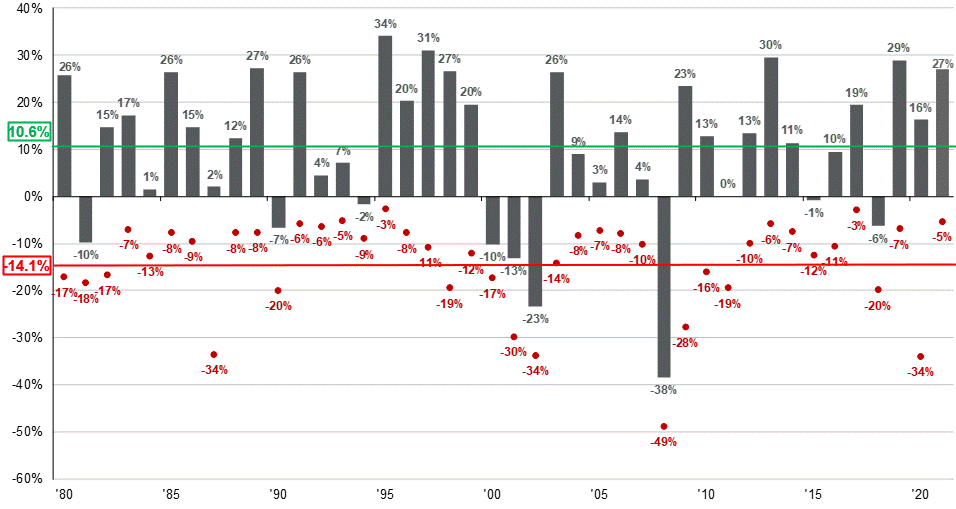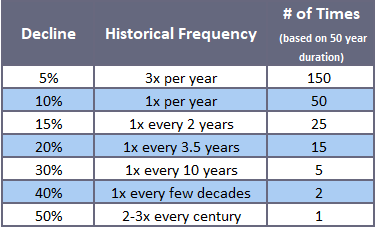Market Volatility: Managing Expectations
Jan 24, 2022 • Written by Paul Staib | Certified Financial Planner (CFP®), MBA, RICP®
Blog Home » Investment Management » Market Volatility: Managing Expectations

When investing in the stock market, it’s critically important to have appropriate and realistic expectations. Recently the level of market volatility has been relatively low. But that is very likely to change given the current macro and geopolitical environment.
Since 1980, the average annual return in the S&P 500 index has been ~10.6%. Unfortunately for investors, market returns over time are not smooth, linear, nor always positive. Rather, the range of return volatility within any given year is significant. Volatility is the price of admission to obtain those attractive longer-term positive returns; you can’t have the benefits of growth without experiencing the accompanying volatility.
Several observations can be made by studying the chart below. It contains the calendar year returns of the SP500 index in gray bars, along with the maximum intra-year drop in red dots of the SP500 index for each year since 1980.
I’ll highlight a couple of points:
- The average annual return was ~+10.6%, as denoted by the green horizontal line;
- The average maximum intra-year decline was -14.1%, as denoted by the red horizontal line;
- In any given year, there is a wide disparity of potential actual return and decline outcomes; the range of return outcomes was +34% to -38%, and the range of decline outcomes was -3 to -49%! Quite a bit of deviation from the averages!
- There were maximum drawdowns of -10% or more in ~55% of the years (23 of 42); yet the calendar year return was positive in ~61% (14 of 23) of those years!
- To obtain the positive return outcomes, investors must be willing to accept the volatility

Market Corrections are Common
Market pullbacks are more common than some may think. Even a 5% decline over a short period can feel unsettling, but they occur on average three times per year. Market corrections of 10% or more are also very common and have happened on average once per year. The accompanying table illustrates the historical frequency of market declines, and the estimated number of times an investor will experience it (assuming a 50 year investing timeframe).

Armed with this information, a 15% decline in your portfolio every other year, and 20% decline every 3-4 years is normal and shouldn’t come as a surprise.
Impact of Time
The amount of time in the market also has a significant impact on volatility and expected return outcomes. It’s basically a coin flip on the odds of making money in any given day (~57% chance of positive return) in the market. Expand the duration to a year and the odds of a positive return increase to ~70%. Further expand the duration to 10+ years and the odds of a positive return approach 100%.
Not only do the probabilities of a positive return increase significantly over time, but so do the corresponding magnitude of returns. So the odds increase from random (1 day) to near certainly (~10+ years) over time while the size of the returns increase from small to potentially transformative. But to obtain this outcome an investor must be willing to be in the market over longer durations, and thereby experience more volatility.
Summary
It’s very natural and easy to become complacent when markets are rising, believing that the market will only increase in value. However, with that growth comes volatility. It’s critically important for investors to expect, mentally prepare for, and manage volatility in order to achieve long-term gains over time.

Paul Staib | Certified Financial Planner (CFP®), MBA, RICP®
Paul Staib, Certified Financial Planner (CFP®), RICP®, is an independent Flat Fee-Only financial planner. Staib Financial Planning, LLC provides comprehensive financial planning, retirement planning, and investment management services to help clients in all financial situations achieve their personal financial goals. Staib Financial Planning, LLC serves clients as a fiduciary and never earns a commission of any kind. Our offices are located in the south Denver metro area, enabling us to conveniently serve clients in Highlands Ranch, Littleton, Lone Tree, Aurora, Parker, Denver Tech Center, Centennial, Castle Pines and surrounding communities. We also offer our services virtually.
Read Next
A Hierarchy for Retirement Savings
• Written By Paul Staib | Certified Financial Planner (CFP®), MBA, RICP®
There are several account options available to investors for retirement savings purposes, including 401(k)s (403(b), 457, and the equivalents), IRA(s),…
Financial Planning – From Pile to Plan
• Written By Paul Staib | Certified Financial Planner (CFP®), MBA, RICP®
A few years ago, I met with a super nice lady I’ll call Eileen. Her husband had passed away, and she…
